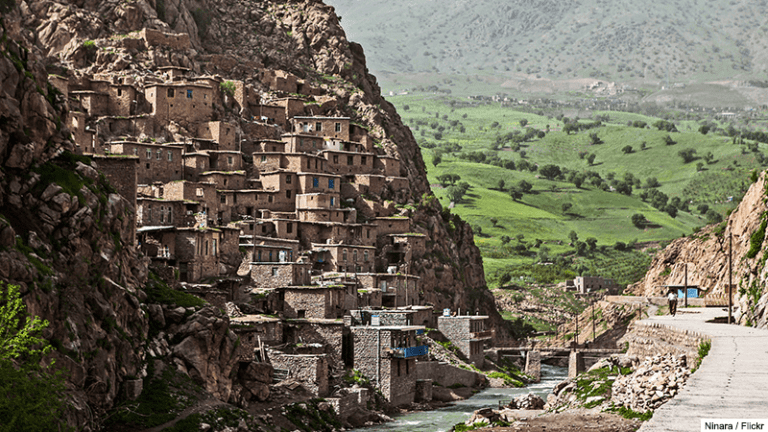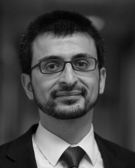
The revival of Kurdish nationalism in the Middle East has largely been discussed in the context of Syria and Iraq, but not Iran—which is the home of seven to nine million Kurds who make up almost 10 percent of the Iranian population. Behind the scant attention is the common perception that a strong state security apparatus and cross-cutting nationalism would constitute a robust wall against separatist ethnic demands in Iran. Realizing the significance of Kurdish votes in a highly competitive election atmosphere, both Hassan Rouhani and Ebrahim Raisi campaigned in Iranian Kurdistan. Despite the calls for boycotting the election by Kurdish expatriate groups, voter turnout in Kurdistan was reported to be high, over 58 percent.
In the past two years, however, the major Kurdish political parties declared their return to armed struggle against the Islamic Republic and began launching attacks. State repression and economic collapse in Kurdish populated regions were steady in Rouhani’s first term despite Kurdish hopes from the reformist leader. The key reason for the resurgence in violence, however, is not necessarily about local grievances but political opportunities that feed growing competition among different Kurdish factions. In the larger Kurdish geography, the active involvement of Kurdish groups to fight against the Islamic State of Iraq and the Levant (ISIL) has empowered them significantly. Militant activism against Tehran is perceived as an opportunity indeed. Various Kurdish parties now seek to expand influence over Iranian Kurds as well as to attract international financial support from Iran’s enemies. The recent ISIL attacks of the Iranian parliament indicate how militant groups exploit the current turmoil in the Gulf region in pursuing their political goals.
As the Kurdistan Regional Government (KRG) in Iraq decided to hold an independence referendum on September 25, 2017, Iran’s Kurdish policy deserves special attention. An independent Kurdistan contiguous to the Iranian Kurdish region may trigger the hawkish regime elements in Tehran—especially in the case of unresolved territorial disputes with the Baghdad government.
Iran’s Kurdish Policy: Increasing Securitization?
Iran’s Kurds and their relations with the state have never been independent from Tehran’s perception of the threat of ethnic separatism. Given Iran’s ethnic diversity, including a large Azeri population, Kurdish cultural demands were long seen through the lens of national security. Following Kemal Ataturk’s path, Shah Reza Pahlavi pursued hardline nationalist policies of centralization, such as banning textbooks and radio broadcasts in non-Persian languages. Iranian Kurdish leaders followed Turkey’s Kurds in reaction. They strongly resisted top-down modernization projects and maintained relations with their ethnic brethren in Iraqi Kurdistan. Most memorably, they established the first modern Kurdish state, the Republic of Kurdistan, in Mahabad city of Iran in 1946. Among the leading figures of the republic was the Defense Minister Mullah Mustafa Barzani, the father of Masoud Barzani, the president of Iraqi Kurdistan today. The Shah’s troops were quick to crush the republic within a year, and Kurds have experienced tense relations with the state since then.
Although Iranian Kurds supported the Islamic Revolution against the shah’s regime, a rocky relationship remained. The Kurds’ request for local autonomy for cultural affairs was met with Khomeni’s declaration of jihad. Tens of thousands were killed in clashes between Kurdish insurgents and the Revolutionary Guards during the 1980s. The post-Cold War era ushered Kurdish autonomy in Iraqi Kurdistan, while Tehran exploited the intra-Kurdish divide between Barzani’s Kurdistan Democratic Party (KDP) and Talabani’s Patriotic Union of Kurdistan (PUK). The Islamic regime under Ali Akbar Hashemi Rafsanjani cultivated good relations with the PUK and began to tolerate Kurdish language publications in Iran. President Mohammad Khatami’s term (1997-2005) was perhaps the best era for Kurdish progress. Kurdish civil society organizations such as cultural and literary associations flourished. Khatami appointed a Kurdish governor, Abdullah Ramazanzade, to the Kurdistan province for the first time and, unprecedentedly, included Kurdish members in his cabinet.
Iranian Kurds have faced serious setbacks in the past decade, starting with former President Mahmoud Ahmadinejad’s securitization policies. Kurdish newspapers were banned. Imprisonment and death penalty executions of Kurdish activists skyrocketed. Strong Kurdish voter support for the election of the reformist president, Hassan Rouhani, in 2013 was apparently a reaction to securitization policies; yet, it did not pay off. As many as 328 Kurds were executed in Rouhani’s first presidential term. In addition to state repression, the economic deterioration of Kurdish regions persisted. Although Rouhani took supportive steps for Kurdish language elective courses in high schools, broader cultural and human rights issues have remained as taboo. That, perhaps, was why the election campaigns of both Rouhani and Raisi largely focused on economic matters. With the unemployment rate reaching a high of 30 percent, Kurdish youth are increasingly frustrated and heavily involved in smuggling of goods from the Iraqi border.
Rearmament of Kurdish Political Parties: Toward a New Pattern
Not surprisingly, all major Kurdish political parties are deemed to be “separatist,” and thus, banned in Iran. Among them, the Democratic Party of Iranian Kurdistan (PDKI) and the Komala Party of Iranian Kurdistan—referred to as Komala—are the oldest and most prominent ones. Founded in 1945, PDKI’s base hailed from the urban middle class in the Mahabad region. Komala, on the other hand, was founded as a revolutionary Marxist group in 1969 and attacked the PDKI for “serving the bourgeoisie.” The civil war between the two escalated during the 1980s but the end of the Cold War caused a gradual weakening of both groups. Despite maintaining armed Peshmerga forces, both groups had declared an end to violence as a means to achieve political goals.
Breaking their two-decades-long silence and signing an agreement to end their infighting, the PDKI and Komala have now returned to armed struggle to fight for a Kurdish federal region in Iran. In March 2015, the PDKI started to dispatch its guerilla units to Iranian Kurdistan and clashed with the Iranian Revolutionary Guard Corps (IRGC) members. Following suit in April 2016, the Kurdistan Freedom Party (PAK) attacked government forces in Sanandaj—a major Kurdish populated city—during the annual Army Day Parade of Iran, announcing their return to arms. Most recently, in May 2017, Komala declared that the group would resume its armed resistance.
The Kurdistan Free Life Party (PJAK), which was founded in 2003 as an affiliate of the Kurdistan Workers’ Party (PKK), has also increased its attacks on Iran’s security forces—most recently on May 23, 2017 in Urmia province. In fact, the PJAK/PKK plan to reach out to Iranian Kurds has triggered a new pattern of competition among Kurds. The PKK’s increasing influence in Syria and Iraq prompted older Iranian Kurdish parties to seek to retain their historical dominance over Iranian Kurds, and thus, to compete with the PJAK through violent means against the Islamic Republic.
The Iranian Kurds’ Achilles heel, however, is the very fact that the Kurdish groups have divergent interests that may be exploited by Iran—to use one faction against another. Another challenge for Kurdish parties is the changing attitudes of Iranian Kurdish youth. The young generation of Kurds often participates in broader civil society activism, calling for economic improvement rather than pro-ethnic rights. Research indicates, for example, that out of 62 non-labor protests in the Kurdish provinces in 2014, most were about the poor economy, environmental issues, and local problems. Iranian Kurdish parties would struggle to persuade young Kurds to abandon low-risk protests for a high-risk ethnic activism. In this sense, economic grievances could be both a catalyst and a barrier for ethnic mobilization in Iran.
Broader Regional Dynamics
The resurgence of conflict between the Kurdish parties and Iran may have serious implications for Iraqi Kurdistan, which hosts the Iranian Kurdish opposition. General Mohammad Pakpour, the commander of IRGC land forces, threatened to launch attacks on PDKI bases if the Kurdish Regional Government (KRG) failed to contain militants. More recently, twin bombings killed seven workers in the politburo office of the PDK, a splinter Kurdish party of PDKI, in Koye in Iraqi Kurdistan. Accusing the IRGC for the bombings, the PDKI and Komala agreed to form a joint commission to work on intelligence sharing to protect their bases inside Iraqi Kurdistan against “Iran’s aggression.” The KRG leadership plays a balancing act by calling Iranian Kurdish parties to consider the interests of Iraqi Kurdistan and simultaneously criticizing Iran for responding disproportionately.
Unprecedentedly, the Iranian Kurdish resurgence has become part of the larger chess game between Saudi Arabia and Iran. The secretary of Iran’s Expediency Council accused Saudi Arabia of supporting PDKI militancy through Riyadh’s consulate in Erbil—which denied the allegations as “baseless.” Regardless of whether the Saudis help the PDKI, competing Iranian Kurdish parties appear to have become more susceptible to outside powers as the war on the Islamic State is coming to an end. In a surprise to many, Iranian officials accused Turkey of facilitating the PJAK’s latest attack in Urmia—despite the PJAK being a PKK-affiliate—while the Turkish media blamed the United States for its alleged support of PJAK.
Given the heightened tension in Iranian Kurdistan, Tehran’s response to the potential declaration of independence by the KRG will have utmost significance. Iran will resist the idea of an independent Kurdistan, especially in the case of an aggressive divorce with Baghdad. Tehran’s hardliners find their views reinforced in former Iraqi Prime Minister Nouri al-Maliki’s recent statement that “the use of force may be necessary” to deter the KRG’s policy to establish “a greater Kurdistan.” The disputed territories in oil-rich Kirkuk and the surroundings of Mosul remain as the key battle issue in Erbil-Baghdad negotiations, which will determine whether the path toward Kurdish independence is smooth or rocky. Without a long-lasting agreement, an independent Kurdistan may increase Tehran’s fear that American and Turkish influence will prevail in Kurdish areas adjacent to Iran’s borders.
Washington’s Complicated Relationship with the Kurds
The competition dynamics of Iranian Kurds will play a role in shaping Washington’s policy toward post-ISIL Iraq. The Trump Administration’s decision to arm the People’s Protection Units (YPG), the PKK’s Syrian affiliate, came with a pledge to Turkey that the PKK’s influence in Iraqi Kurdistan will be curbed. Having deep-rooted problems with the PKK, the KRG leadership also requested Washington’s help on this issue, especially in the removal of PKK units from the Sinjar region. US State department officials signaled a potential US-Turkey-KRG cooperation against Sinjar’s PKK forces, which lately are collaborating with Iran-backed militias. The PKK affiliate PJAK’s recent attacks in Iranian Kurdistan, therefore, may be interpreted as a move to offset Washington’s skepticism of the PKK-Iran rapprochement. According to former PJAK fighters, the PKK had founded PJAK in 2003 soon after the fall of Saddam Hussein’s regime because the group perceived an opportunity “to assure itself a potential role should the United States decide to move against Iran.”
As the war on ISIS in Mosul enters its final stage, Washington is likely to increase its pressure over the PKK in Iraqi Kurdistan. In the case of ensuing tensions between the KRG and the PKK, Iranian Kurdish parties—mainly, PDKI and Komala—may choose to support the Barzani government despite their cultivation of good relations with the opposition in Iraqi Kurdistan. Thus, the ongoing competition between PJAK and Iranian Kurdish parties is destined to continue in near future.
In this regard, the White House’s policy toward KRG independence will be most critical in shaping not only the trajectory of Iranian Kurds but also Iran’s perception of an imminent threat. Without a strong diplomatic lead by the United States, Erbil-Baghdad relations may deteriorate further. If the Shia militia units move toward a collision course with the Kurdish Peshmerga in the disputed territories after the Mosul operation, the KRG would unilaterally declare independence. Under such a scenario, however, Iran’s perception of the Kurdish threat will reach its peak.

